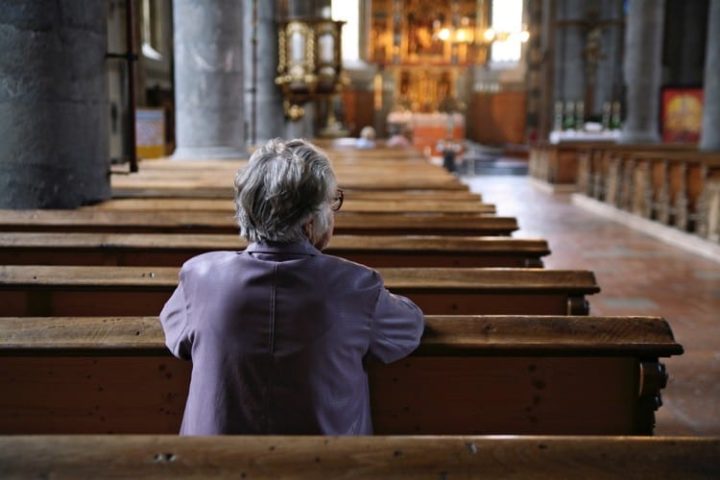
Some Americans are so far “left” that they’ve left sanity, and this just could be because they first left faith. They are leaving it, too. In fact, a recent Gallup survey found that Americans who belong to a house of worship are a minority for the first time ever in history. It’s a phenomenon with serious political implications, as regular church attendance, or lack thereof, correlates with voting patterns.
American Thinker reported on the survey Monday, writing:
The recent poll found that only 47% of Americans reported membership in a place of worship in 2020, continuing a steep downward trend that began in the early 2000s. In 1937, when Gallup first began tracking church membership, 73% of Americans reported belonging to a house of worship. Membership (and church attendance) continued at nearly the same high levels for almost seven more decades. In 1999, 70% of Americans still said they belonged to a house of worship. For some reason, or reasons, membership began steadily declining in the early 2000s, a trend that continues apace, with no sign of slowing.
Gallup said of its survey’s findings: “Over the past two decades, the percentage of Americans who do not identify with any religion has grown from 8% in 1998–2000 to 13% in 2008–2010 and 21% over the past three years. As would be expected, Americans without a religious preference are highly unlikely to belong to a church, synagogue or mosque, although a small proportion — 4% in the 2018–2020 data — say they do. That figure is down from 10% between 1998 and 2000.”
Those from younger generations in particular are rapidly abandoning or avoiding religion. Gallup noted, “Church membership is strongly correlated with age, as 66% of traditionalists — U.S. adults born before 1946 — belong to a church, compared with 58% of baby boomers, 50% of those in Generation X and 36% of Millennials.” (The flight from Christian churches is even more striking when you realize that a higher percentage of Americans are members of a mosque than ever before, though that percentage is still low.)
This pattern of decreasing religiosity has been supported by other research as well. For example, a 2015 Pew Research Foundation study involving more than 35,000 Americans found that those identifying as Christian lost almost eight points in population share between 2007 and 2014, declining from 78.4 percent to 70.6 percent. In contrast, the religiously “unaffiliated” comprised almost a quarter of the U.S. population in 2015, with their share increasing 6.7 points from 16.1 to 22.8 percent.
This helps explain 2021’s “wokeism.” For one of the best indicators of political passions and voting patterns is religious attendance. Upwards of 6 out of 10 voters who attend worship services more than weekly vote Republican, Pew found via earlier research; this ratio reverses itself for those who never attend, with more than 6 out of 10 voting Democrat.
This reflects that commonly understood correlation between traditional American religiosity and “conservative” belief. Defining it even more precisely, the more passionately Christian people are, the more “conservative” they generally will be. As to this, President Trump’s 2020 evangelical support stood at 61 percent, and 76 percent of white evangelicals voted for him last November.
Another good example of this voting-pattern phenomenon is Sweden: This most atheistic Western nation is also probably the most left-wing. (Now you know why the Left attacks Christianity so feverishly.)
In explaining America’s drift from Christian faith, many would point to anti-Christian messages in academia, entertainment, and the media. But a little-understood factor, and perhaps a greater one, is today’s rampant moral relativism/nihilism, which breeds emotion-based decision-making.
Consider: The very basis of the faith is that Jesus died on the cross for man’s sins and thus redeemed us. But if everything is relative, there can be no sin — only perspective or preference.
And then there was no reason for Jesus to sacrifice himself in the first place.
Moreover, Christianity may teach that Jesus is the way, the life, and the Truth, but how likely are people to believe this if they don’t believe in Truth to begin with? In fact, why would they even search for Truth, a process otherwise known as philosophical pursuit, if they don’t believe it exists?
Of course, without a need to be redeemed from sin or a need of moral teaching (because there is no perceived morality), there’s no perceived need for Christianity. And people generally discard what they don’t need.
Besides, if everything is relative and therefore a matter of perspective, why subject yourself to Christianity’s limits on man’s appetites? You may as well just be a hedonist — or at least a Unitarian.
Oh, how severe is our Truth crisis (our relativism)? Well, 2002 Barna Group research — examining a problem that has only worsened since — found that only nine percent of “born again” teens believe in Truth (absolute by definition). Furthermore, Barna found that most Americans make “moral” decisions based on feelings.
The good news is that, according to Pew and other research entities, religiosity is actually poised to increase globally during the next few decades, while atheists’/the religiously unaffiliated’s share of the world population is slated to decline. Why, even Catholicism, mocked by secularists as a dying religion, continues to grow worldwide.
So there’s no sign that the gates of Hell will prevail against Christianity. The West, though, where faith is now in decline, may be a different story.



